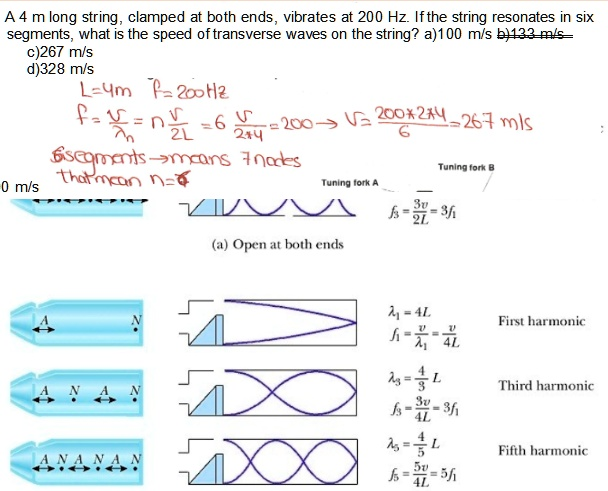A 4 m long string, clamped at both ends, vibrates at 200 Hz

The correct answer is c) 267 m/s.
Explanation:
This problem involves calculating the speed of a transverse wave on a string that is vibrating to form a standing wave. Here is a step-by-step breakdown of the solution.
1. Identify Given Information:
- Length of the string (L) = 4 m
- Frequency of vibration (f) = 200 Hz
- The string is clamped at both ends, which means the ends must be nodes (points of zero displacement).
- The string resonates in six segments.
2. Understand the Physics of Standing Waves:
For a string fixed at both ends, a standing wave can be established only at specific frequencies called resonant frequencies. These resonant modes are called harmonics. The number of “segments” or “loops” seen on the vibrating string corresponds to the harmonic number, denoted by ‘n’. Each segment spans between two adjacent nodes and contains one antinode (a point of maximum displacement).
Therefore, if the string resonates in six segments, it is vibrating in its 6th harmonic, so n = 6.
3. Relate Wavelength to String Length:
The total length of the string (L) must be an integer multiple of half wavelengths (λ/2) for a standing wave to form. The formula relating the string length, harmonic number, and wavelength is:
L = n * (λn / 2)
where λn is the wavelength of the nth harmonic.
We can use this relationship to find the wavelength of the wave on the string:
4 m = 6 * (λ₆ / 2)
4 m = 3 * λ₆
λ₆ = 4 / 3 m
4. Calculate the Wave Speed:
The speed of any wave (v) is related to its frequency (f) and wavelength (λ) by the fundamental wave equation:
v = f * λ
Using the frequency of the 6th harmonic (f₆ = 200 Hz) and the calculated wavelength (λ₆ = 4/3 m), we can find the wave speed:
v = 200 Hz * (4 / 3 m)
v = 800 / 3 m/s
v ≈ 266.67 m/s
5. Alternative Method using the Harmonic Frequency Formula:
A more direct formula for the resonant frequencies of a string fixed at both ends is:
fn = n * (v / 2L)
We can rearrange this formula to solve for the wave speed (v):
v = (fn * 2L) / n
Now, we can substitute the known values into this equation:
- fn = f₆ = 200 Hz
- n = 6
- L = 4 m
v = (200 Hz * 2 * 4 m) / 6
v = (200 * 8) / 6
v = 1600 / 6
v ≈ 266.67 m/s
Conclusion:
Both methods yield a wave speed of approximately 266.67 m/s. Comparing this result with the given options, the closest choice is 267 m/s.
